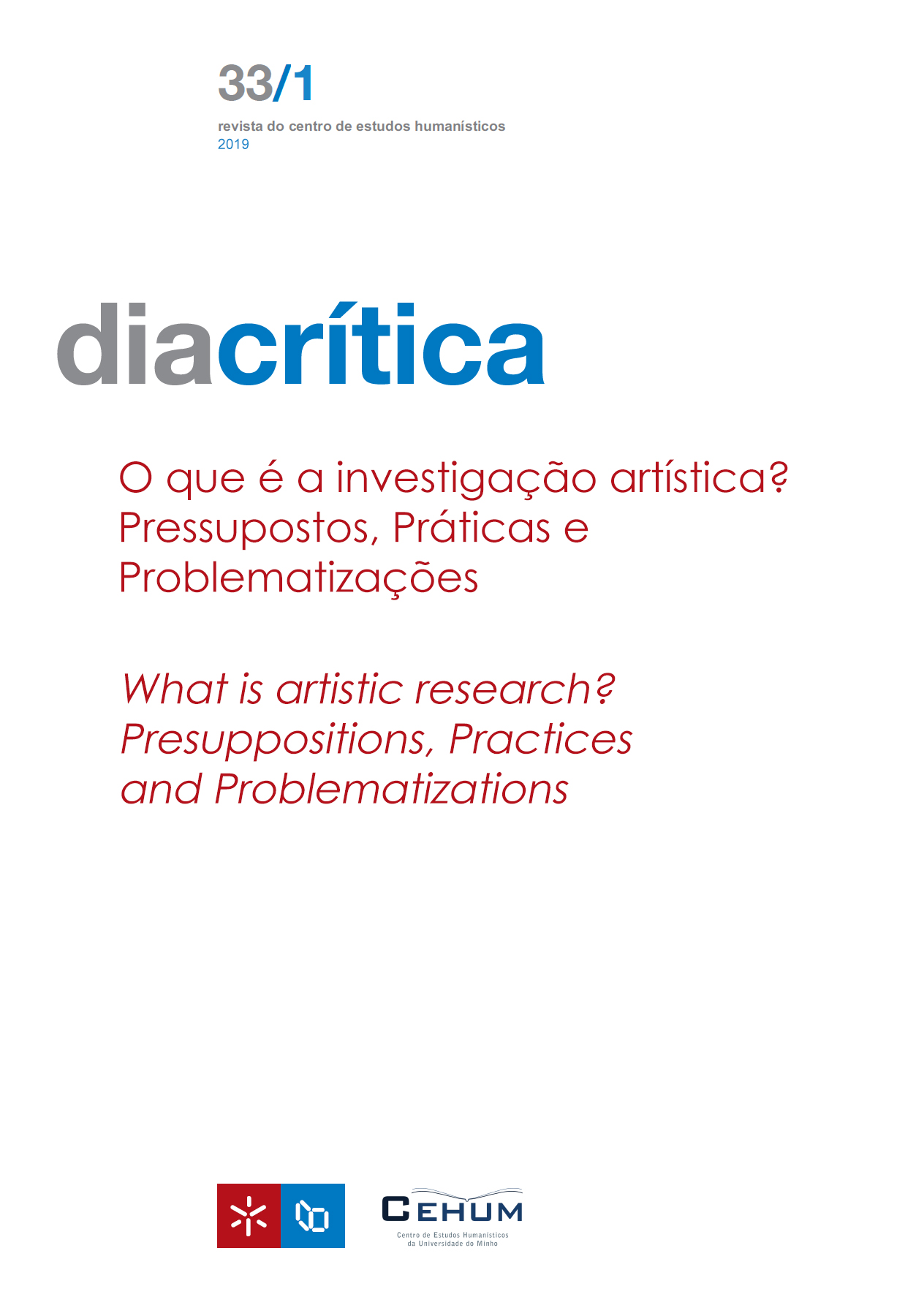Cartography and artography as living methods of research in art and art education
DOI:
https://doi.org/10.21814/diacritica.5042Keywords:
Artistic research methods, Cartography, Artography, Living inquiryAbstract
It is intended to address two methods that have been used by recent researchers in the writing of their dissertations and theses, with particular emphasis on those that have been implemented (not without resistance) in some university institutions that have dared to break with traditional methods of research, not only in areas such as the arts, but also in those that belong to what has been called the humanities. The performative and undeniably ‘artistic’ dimension of this work escapes from the evaluation criteria and respective parameters of analysis currently used in qualitative research. It has clear limitations to evaluate the artistic, and what imply ineffable and phenomenological, especially if we position ourselves from the place of the researcher-artist aware of the unique and unrepeatable nature of his work and practice.
References
Alonso-Sanz, A. (2013). A favor de la investigación plural en educación artística. Integrando diferentes enfoques metodológicos.Arte, Individuo y Sociedad, 25(1), 111–120. DOI: https://doi.org/10.5209/rev_ARIS.2013.v25.n1.41167
Barone, T. & Eisner, E. (2006). Arts-based educational research. In J. Green, G. Camille&P. Belmore(Eds.),Handbook of complementary methods in educationalresearch(pp. 95–109). New Jersey: AERA.
Bourdieu, P. (2004). Os usos sociais da ciência: por uma sociologia clínica do campo científico. S. Paulo: Editora UNESP.
Charréu, L. (2018). A pesquisa educacional baseada nas artes (PEBA): Os seus elementos de concepção segundo Elliot Eisner. Revista Portuguesa de Educação Artística, 8(1), 17–29.
Charréu, L. & Oliveira, M. O. (2015). A/r/tography in practice: reviewing three research projects at the Federal University of Santa Maria, Brazil. In AAVV,2nd Encounter on practices of research in arts education: some texts(pp. 63–75). Porto: I2ADS-NEA, Faculdade de Belas Artes da Universidade do Porto.
Deleuze, G. & Guattari, F. (2011). Mil platôs.Vol.1. Rio de Janeiro: Ed.34.
Dias, B. (2009). Uma epistemologia de fronteiras: Minha tese de doutorado como um projeto a/r/tográfico. In AAVV,Anais 18. Anpap(pp. (3173–3187). Salvador: ANPAP.
Dias, B. (2013). A/r/tografia como metodologia e pedagogia em artes: uma introdução. InB.Dias & R. Irwin (Eds.),Pesquisa educacional baseada em arte: a/r/tografia(pp.6–12). Santa Maria: Edufsm,
Huss, E & Cwikel, J. (2005). Researching creations: Applying arts-based research to bedouin women’s drawings. International Journal of Qualitative Methods, 4(4), 44-62. DOI: https://doi.org/10.1177/160940690500400404
Irwin, R. (2008). A/r/tografia: uma mestiçagem metonímica. In A. M. Barbosa & L.Amaral(Eds.),Interterritorialidade: mídias, contextos e educação(pp. 87–104).São Paulo: SENAC.
Irwin, R. (2013). A/r/tografia: uma introdução. In B. Dias & R. Irwin (Eds.),Pesquisa educacional baseada em arte: a/r/tografia(pp. 13–23).SantaMaria: Edufsm.
Lima de Souza, S. & Francisco A. (2016). O método da cartografia em pesquisa qualitativa:estabelecendoprincípios, desenhandocaminhos.In A. P.Costa et al.(Eds.),Atas do Vº Congresso Ibero-americano em investigação qualitativa,Vol2:Investigação qualitativa na saúde(pp. 811–820). Porto: Edição Ludomedia.
Marín-Viadel, R. (2005).La “Investigación educativa basada en las artes visuales” o “Arteinvestigación educativa”. In R. Marín (Ed.), Investigación en educación artística(pp. 223–274). Granada: Editorial Universidad de Granada.
Oliveira, M. O. & Charréu, L. (2016). Contribuições da perspectiva metodológica investigação baseada nas artes e da a/r/tografia para as pesquisas em educação. Educação em Revista, 31(1), 365–382. DOI: https://doi.org/10.1590/0102-4698140547
Popper, K. (1959). The logic of scientific discovery. New York: Basic Books. DOI: https://doi.org/10.1063/1.3060577
Popper, K. (1963). Conjectures and refutations. London: Routledge. DOI: https://doi.org/10.1063/1.3050617
Roldán, J. & Marín-Viadel, R. (2012). Metodologias artísticas de investigación en educación, Málaga: Ediciones Aljibe.
Rolnik, S. (1989).Cartografia sentimental. Transformações contemporâneas do desejo. São Paulo: Editora Estação Liberdade.
Romagnoli, R. C. (2009). A cartografia e a relação pesquisa vida. Psicologia & sociedade, 21(2), 166–173. DOI: https://doi.org/10.1590/S0102-71822009000200003
Rosa, A. (2015). Sobre mudarde paisagens, sobre mirar com outros olhos –narrativas a partir de deslocamentos territoriais(Tese de doutoramento-não publicada,Universidade Federal de Goiás).
Santos, B.de S. (2002). Um discurso sobre as ciências. Porto: Afrontamento.
Springgay, S. (2008). Body knowledge and curriculum. Pedagogies of touch in youth and visual culture. New York: Peter Lang Publishing.
Springgay, S.,Irwin, R. & Kind, S. (2005).A/r/tography as living Inquiry through art and text Qualitative Inquiry, 11(6), 807–912. DOI: https://doi.org/10.1177/1077800405280696
Downloads
Published
How to Cite
Issue
Section
License
Copyright (c) 2023 Leonardo Verde Charréu

This work is licensed under a Creative Commons Attribution-NonCommercial 4.0 International License.










